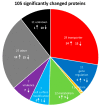Proteomic Adaptation of Streptococcus pneumoniae to the Human Antimicrobial Peptide LL-37
- PMID: 32183275
- PMCID: PMC7143398
- DOI: 10.3390/microorganisms8030413
Proteomic Adaptation of Streptococcus pneumoniae to the Human Antimicrobial Peptide LL-37
Abstract
Secreted antimicrobial peptides (AMPs) are an important part of the human innate immune system and prevent local and systemic infections by inhibiting bacterial growth in a concentration-dependent manner. In the respiratory tract, the cationic peptide LL-37 is one of the most abundant AMPs and capable of building pore complexes in usually negatively charged bacterial membranes, leading to the destruction of bacteria. However, the adaptation mechanisms of several pathogens to LL-37 are already described and are known to weaken the antimicrobial effect of the AMP, for instance, by repulsion, export or degradation of the peptide. This study examines proteome-wide changes in Streptococcus pneumoniae D39, the leading cause of bacterial pneumonia, in response to physiological concentrations of LL-37 by high-resolution mass spectrometry. Our data indicate that pneumococci may use some of the known adaptation mechanisms to reduce the effect of LL-37 on their physiology, too. Additionally, several proteins seem to be involved in resistance to AMPs which have not been related to this process before, such as the teichoic acid flippase TacF (SPD_1128). Understanding colonization- and infection-relevant adaptations of the pneumococcus to AMPs, especially LL-37, could finally uncover new drug targets to weaken the burden of this widespread pathogen.
Keywords: LL-37; Streptococcus pneumoniae; adaptation; antimicrobial peptide; proteomics.
Conflict of interest statement
The authors declare no conflict of interest. The funders had no role in the design of the study; in the collection, analyses, or interpretation of data; in the writing of the manuscript, or in the decision to publish the results.
Figures







Similar articles
-
Proteomic Adaptation of Streptococcus pneumoniae to the Antimicrobial Peptide Human Beta Defensin 3 (hBD3) in Comparison to Other Cell Surface Stresses.Microorganisms. 2020 Oct 30;8(11):1697. doi: 10.3390/microorganisms8111697. Microorganisms. 2020. PMID: 33143252 Free PMC article.
-
The Opp (AmiACDEF) Oligopeptide Transporter Mediates Resistance of Serotype 2 Streptococcus pneumoniae D39 to Killing by Chemokine CXCL10 and Other Antimicrobial Peptides.J Bacteriol. 2018 May 9;200(11):e00745-17. doi: 10.1128/JB.00745-17. Print 2018 Jun 1. J Bacteriol. 2018. PMID: 29581408 Free PMC article.
-
Differential Expression of Antimicrobial Peptides in Streptococcus pneumoniae Keratitis and STAT3-Dependent Expression of LL-37 by Streptococcus pneumoniae in Human Corneal Epithelial Cells.Pathogens. 2019 Mar 6;8(1):31. doi: 10.3390/pathogens8010031. Pathogens. 2019. PMID: 30845777 Free PMC article.
-
Cationic antimicrobial peptide resistance mechanisms of streptococcal pathogens.Biochim Biophys Acta. 2015 Nov;1848(11 Pt B):3047-54. doi: 10.1016/j.bbamem.2015.02.010. Epub 2015 Feb 17. Biochim Biophys Acta. 2015. PMID: 25701232 Free PMC article. Review.
-
Antimicrobial Peptides: Mechanisms of Action and Resistance.J Dent Res. 2017 Mar;96(3):254-260. doi: 10.1177/0022034516679973. Epub 2016 Nov 25. J Dent Res. 2017. PMID: 27872334 Free PMC article. Review.
Cited by
-
The Role and Mechanisms of Antimicrobial Peptides in Overcoming Multidrug-Resistant Bacteria.Molecules. 2024 Dec 31;30(1):128. doi: 10.3390/molecules30010128. Molecules. 2024. PMID: 39795190 Free PMC article. Review.
-
The Role of Proteomics in Bacterial Response to Antibiotics.Pharmaceuticals (Basel). 2020 Aug 27;13(9):214. doi: 10.3390/ph13090214. Pharmaceuticals (Basel). 2020. PMID: 32867221 Free PMC article. Review.
-
Myxopyronin B inhibits growth of a Fidaxomicin-resistant Clostridioides difficile isolate and interferes with toxin synthesis.Gut Pathog. 2022 Jan 6;14(1):4. doi: 10.1186/s13099-021-00475-9. Gut Pathog. 2022. PMID: 34991700 Free PMC article.
-
The Potential of Human Peptide LL-37 as an Antimicrobial and Anti-Biofilm Agent.Antibiotics (Basel). 2021 May 29;10(6):650. doi: 10.3390/antibiotics10060650. Antibiotics (Basel). 2021. PMID: 34072318 Free PMC article. Review.
-
Respiratory tract infections: an update on the complexity of bacterial diversity, therapeutic interventions and breakthroughs.Arch Microbiol. 2024 Aug 17;206(9):382. doi: 10.1007/s00203-024-04107-z. Arch Microbiol. 2024. PMID: 39153075 Review.
References
-
- WHO The Top 10 Causes of Death. [(accessed on 14 November 2019)]; Available online: http://www.who.int/mediacentre/factsheets/fs310/en/
-
- WHO Pneumonia. [(accessed on 14 November 2019)]; Available online: http://www.who.int/mediacentre/factsheets/fs331/en/
-
- Ladhani S.N., Collins S., Djennad A., Sheppard C.L., Borrow R., Fry N.K., Andrews N.J., Miller E., Ramsay M.E. Rapid increase in non-vaccine serotypes causing invasive pneumococcal disease in England and Wales, 2000-17: A prospective national observational cohort study. Lancet Infect. Dis. 2018;18:441–451. doi: 10.1016/S1473-3099(18)30052-5. - DOI - PubMed
-
- WHO WHO Publishes List of Bacteria for Which New Antibiotics Are Urgently Needed. [(accessed on 14 November 2019)]; Available online: http://www.who.int/mediacentre/news/releases/2017/bacteria-antibiotics-n...
Grants and funding
LinkOut - more resources
Full Text Sources
Molecular Biology Databases

